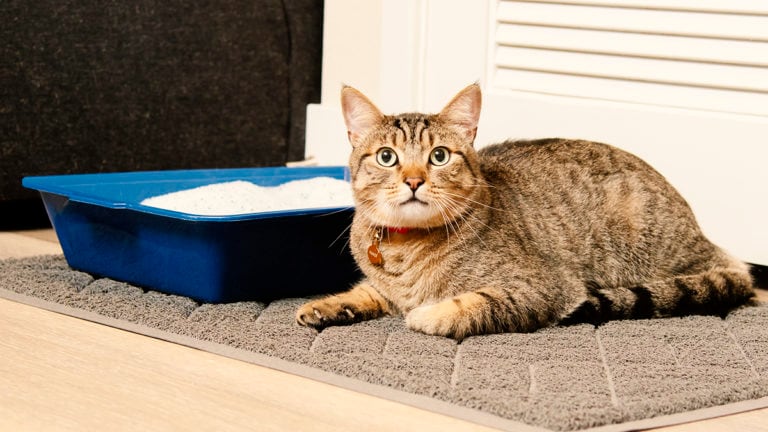Regular litter box cleaning is a daily task for most cat parents that not only raises overall pet health and comfort levels, but also keeps their home smelling fresh.
Selecting the right litter box can improve the quality of life for you and your felines—but if you’ve shopped for pet goods lately, you know there are many different options to choose from. With help from Dr. Rachel Barrack, DVM, CVA, CVCH at Animal Acupuncture in New York City, we put together the top considerations when shopping for a cat litter box, whether you’re welcoming a new family member or making an upgrade.
Think ahead. When you’re first wondering how to litter train a kitten, it can be easy to overlook the obvious: buying a litter pan. “First and foremost, make sure to have your new litter box ready before you bring a new cat home,” says Dr. Barrack. “This is extremely important, because if the litter box is not already set up when your cat comes home for the first time, she might use another spot—say, a houseplant!—and it will be difficult to get her to switch to the litter box.”
Size things up. Consider measurements, not only of the box, but of your cat! Most litter boxes are sized for a typical cat, but as you’ve probably noticed, typical can mean 8 pounds for your dainty female, Princess, or 20 pounds for Tiger, your Maine Coon. If you have the room for it, an extra-spacious box is ideal—while a too-small one can result in your cat’s rear end sometimes hanging outside the area of the box. The jumbo-sized Petmate Hi-Back Litter Pan will work for your big-boned baby, and also has Microban to fight bacteria
If you’re trying to figure out how to litter train a kitten, you may assume that a litter box made specifically for kittens is best. While you can certainly start out with one of these, keep in mind that your cat will grow faster than you might expect, and that tiny box will need to be replaced soon. Not only is that an added cost, but then you will essentially have to retrain your pet to use the bigger box. Cats, even adult ones, get accustomed to their boxes, so there is usually at least a brief period of adjustment when a new one is swapped in.
Check out different types of litter boxes. When perusing pet goods for your cat, a litter box is one of the most important purchases. There are several types to choose from, and each has its pros and cons. Remember, pet health depends on a pet parent’s diligence in providing their cats with a clean place to relieve themselves. This is true no matter which litter box you buy.
Open litter boxes are the least expensive, and come in a wide variety of brand, color and size options. The downside here is that you will see (and sometimes, smell) the contents. Plus, “If you have a dog, this is important to keep in mind. He will have access to the litter box, and will most likely help himself to what’s inside,” points out Dr. Barrack. Icky, but true! However, if your kitty insists on an open litter box, but you have a curious dog, you can raise it up on a small table, leaving part of the table clear for your cat to jump on before stepping into the box.
Domed litter boxes eliminate that problem, but cost a bit more. “Yet, it could be worth it to give your cat some privacy, and also protect other animals in the home from having access to her waste,” says Dr. Barrack. Another perk many pet parents find with a domed litter box is that it contains the litter, which helpful if you have a cat that really likes to kick things up after doing her business. Nature’s Miracle Advanced Hooded Corner Litter Box is shaped to fit neatly into any corner.
Electric litter boxes are a bit pricier, but “if you have the budget for it, electric litter boxes are a great choice,” insists Dr. Barrack. These boxes are designed to scoop automatically, which means less work for you. Just keep in mind that some pet parents have noticed their cats being put off by the sound these boxes make. While that may well not be an issue for your cat, if she is the skittish type, it might be a good idea to take how quiet a particular electric litter box is into account. The ScoopFree Original Self Cleaning Litter Box is quieter than most.
Disposable litter pans are tempting, but can be a budget-buster for many pet parents, aside from being not so eco-friendly. They’re best used as temporary travel litter boxes. An ideal compromise may be the Tidy Cats Breeze Litter Box System. The box is designed so that special nuggets of litter allow urine to drip through onto a disposable pad, which is replaced every 5-7 days.
Litter box furniture is a new, fun option, notes Dr. Barrack. Let’s face it: few people would consider their litter box a stylish home accessory. “These litter boxes can be disguised as a side table or even a dollhouse,” says Dr. Barrack. These tend to be space eaters, though, so they may not be the best choice for a small apartment.
Share:













